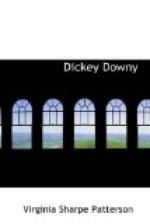“Oh, yes; they tell us so because they want to prevent us from getting alarmed, since so much has been said against the destruction of the birds. It is true that chicken feathers always have been used to some extent, the straight quills for instance. I know it is frequently broadly asserted that the most of the birds used are made birds, but the manufactured creatures are poor deceptions; they are mixed with bird feathers, and are sold only to the less fastidious customers. The demand for genuine birds is as great as ever.”
“But do you think as many are used now as formerly?” questioned her companion.
“Yes, indeed! Just think of the feather capes and muffs and collarettes made of birds. The market for them is increasing all the time. It takes from eighteen to twenty-five skins for each collar, and I don’t know how many for the muffs. Oh, I tell you, women are heaping up judgment on themselves.”
The other lady looked grave. “I understand,” said she, “that in many places down on the New Jersey coast the boatmen have given up fishing, as they can make so much more money killing terns and gulls for women’s use. They earn fifty dollars a week at it, at ten cents apiece for the birds. Isn’t that a horrible record for women?”
“I don’t doubt they earn that much, and perhaps more,” answered Mrs. Brown; “for one season there were thirty thousand terns killed in one locality alone. And at Cape Cod, and up along the shore near where I lived, they are slain by thousands every season and shipped to New York. Oh, I can’t tell you how distressing it used to be to hear the report of the guns day after day and know that every piercing sound was the sign that more innocent lives were being taken. I used to cover up my ears and try not to hear them. It made me shiver to know that those poor gulls were being shot down for nothing. Their only crime consisted in being beautiful.”
Both women turned at that moment attracted by the sight of a young lady who was standing on the pavement outside in an animated talk with another girl.
“There’s Miss Van Dyke, with her new feather collar on,” observed Mrs. Brown, in a low voice.
The young lady in question was a dashing, radiant creature, bright with smiles and a face like a picture. On her shapely shoulders was a magnificent cape, lustrous as satin, of silvery white, into which pale dark lines softly blended at regular intervals. Twenty-two innocent lives had been taken to make that little garment. Twenty-two beautiful grebes slain that their glossy breasts might lend splendor to a lady’s wardrobe.
The two friends looked at Miss Van Dyke in silence for a moment, then sighed as she passed along out of their view.
“When I see such perversion of woman’s nature I wonder that the very stones do not cry out against us,” exclaimed Mrs. Brown. “And mark my words, the slaughter will go on; the unholy traffic will not long be confined to grebe’s breasts for muffs and cape trimmings. Other birds will be used. The gentle creatures are not all put on hats.”




